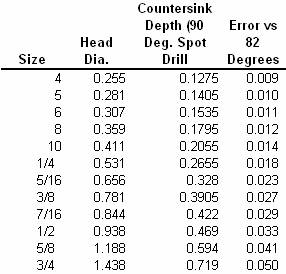Stan said:
I must be doing something wrong since I haven't found any way to tell within a few thou of where the countersink touches off in the screw clearance hole. I seem to find the correct depth for the first screw by trial and error and then go the same depth for the rest of that size.
BTW: 90 degree countersinks are for 90 degree screws which should be used in thin metal. An incorrect countersink angle has the screw head hanging on the edge or else sitting with no contact at the edge giving very little holding strength.
Well if you used the spotting drill as the countersink, the hole is countersunk first, and so your touch off is against a flat surface and will be easier.
RE how much less holding strength? It will certainly be somewhat less, but one wonders about it being "very little". After all, Machinery's Handbook says the spec on the bolt head itself allows a variation of 78 to 82 degrees. So an 82 degree countersink is pinned at the high end of the range. This makes me think a couple of things. First, if that much difference is allowable without changing the spec of what the bolt is supposed to be capable of, an extra 8 degrees at the other end probably won't be the end of the world. Second, it's evidently more desirable for the countersink to have a greater angle than the bolt head, hence if I didn't have an 82, I'd rather a 90 than a 60.
And speaking of 60's, Machinery's Handbook says you should slightly chamfer the bolt clearance hole with a 60 degree tool to account for the slight radius between the socket head cap screw and the threaded portion of the bolt. Learn something new every day!
While I was looking through the Handbook, I saw all kinds of angles. As Tim, and then Brian said, metric is 90. But, Instrument screws in Imperial, for example, are also 90 degrees. Seems like the sort of thing a fellow who worked on small engines might possibly come across. There were a number of others, and all had a range of angles within which the bolt was "in spec."
I even went over to Practical Machinist and had a look around. One group of fellas opined as how most aerospace work uses 100 degree screws. They hold better on thin aircraft skins. As Stan mentions and as the Handbook mentions, more angle = better for thin stuff. Kinda makes you wonder about metric when small fasteners are involved because you have 90 instead of 82.
Times like this it sure is handy to have a grinder and the ability to make the tool do whatever angle you'd like. ;D
Cheers,
BW





